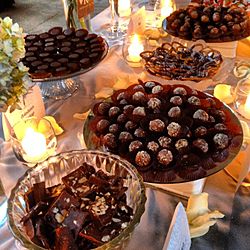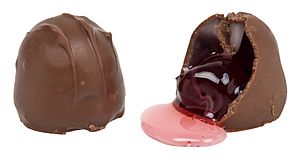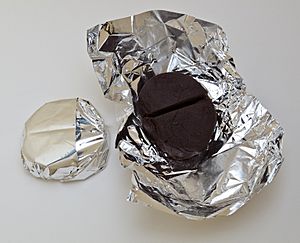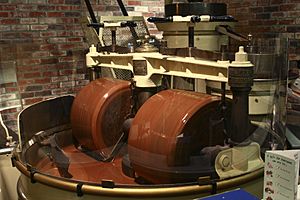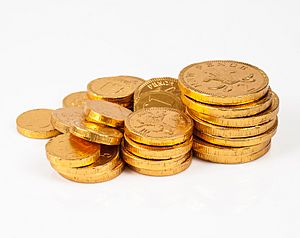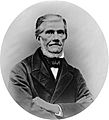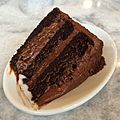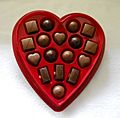Chocolate facts for kids
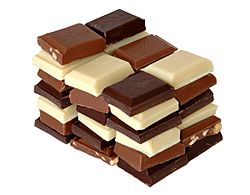
Chocolate most commonly comes in dark, milk, and white varieties, with cocoa solids contributing to the brown color.
|
|
| Main ingredients | Chocolate liquor, cocoa butter for white chocolate, often with added sugar |
|---|---|
Chocolate is a food made from the seeds of a cacao tree. It is used in many desserts like pudding, cakes, candy, and ice cream. It can be a solid form like a candy bar or it can be in a liquid form like hot chocolate. The taste of chocolate is often described as sweet because chocolate makers usually add a lot of sugar and milk for taste. This means that chocolate can be bad for your teeth and health. It is best to eat chocolate in moderation.
After fermentation, the beans are dried, cleaned, and roasted. The shell is removed to produce cacao nibs, which are then ground to cocoa mass, unadulterated chocolate in rough form. Once the cocoa mass is liquefied by heating, it is called chocolate liquor. The liquor also may be cooled and processed into its two components: cocoa solids and cocoa butter. Baking chocolate, also called bitter chocolate, contains cocoa solids and cocoa butter in varying proportions, without any added sugars. Much of the chocolate consumed today is in the form of sweet chocolate, a combination of cocoa solids, cocoa butter or added vegetable oils, and sugar. Milk chocolate is sweet chocolate that additionally contains milk powder or condensed milk. White chocolate contains cocoa butter, sugar, and milk, but no cocoa solids.
Chocolate has become one of the most popular food types and flavors in the world, and a vast number of foodstuffs involving chocolate have been created, particularly desserts including cakes, pudding, mousse, chocolate brownies, and chocolate chip cookies. Many candies are filled with or coated with sweetened chocolate, and bars of solid chocolate and candy bars coated in chocolate are eaten as snacks. Gifts of chocolate molded into different shapes (e.g., eggs, hearts) have become traditional on certain Western holidays, such as Easter and Valentine's Day. Chocolate is also used in cold and hot beverages such as chocolate milk and hot chocolate.
Although cocoa originated in the Americas, recent years have seen African nations assuming a leading role in producing cocoa. Since the 2000s, Western Africa produces almost two-thirds of the world's cocoa, with Ivory Coast growing almost half of that number.
Contents
History of chocolate
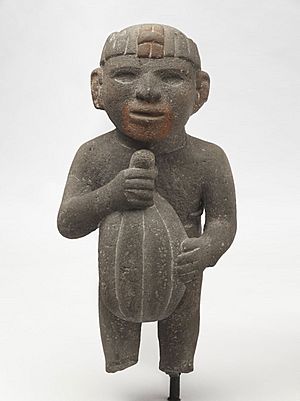
The cacao tree was first found to be useful for its seeds about two thousand years ago. Early Central Americans and Mexicans used the seeds from the cacao tree to make a drink that tasted bitter, not sweet. Only the important people could drink it. The word for "chocolate" in almost every language comes from its name in the Nahuatl language of Mexico, chocolatl.
Later on, this drink was made sweeter and made into the treat that is known today as hot chocolate. It was made popular by Spanish explorers who brought it from North America to Spain. When chocolate was sweetened and made into candy, it became a very popular treat for many Europeans. At first, only the rich could afford chocolate. Now, many people enjoy it. Most cocoa today is made in Africa.
Types of chocolate
Several types of chocolate can be distinguished. Pure, unsweetened chocolate, often called "baking chocolate", contains primarily cocoa solids and cocoa butter in varying proportions. Much of the chocolate consumed today is in the form of sweet chocolate, which combines chocolate with sugar.
Milk chocolate is sweet chocolate that also contains milk powder or condensed milk.
White chocolate, although similar in texture to that of milk and dark chocolate, does not contain any cocoa solids. Because of this, many countries do not consider white chocolate as chocolate at all. Because it does not contain any cocoa solids, white chocolate does not contain any theobromine, so it can be consumed by animals.
Dark chocolate is produced by adding fat and sugar to the cacao mixture.
Unsweetened chocolate is pure chocolate liquor, also known as bitter or baking chocolate. It is unadulterated chocolate: the pure, ground, roasted chocolate beans impart a strong, deep chocolate flavor. It is typically used in baking or other products to which sugar and other ingredients are added. Raw chocolate, often referred to as raw cacao, is always dark and a minimum of 75% cacao.
Poorly tempered chocolate may have whitish spots on the dark chocolate part, called chocolate bloom; it is an indication that sugar and/or fat has separated due to poor storage. It is not toxic and can be safely consumed.
Effects on health
Chocolate may be a factor for heartburn in some people because one of its constituents, theobromine.
Excessive consumption of large quantities of any energy-rich food, such as chocolate, without a corresponding increase in activity to expend the associated calories, can increase the risk of weight gain and possibly obesity. Raw chocolate is high in cocoa butter, a fat which is removed during chocolate refining, then added back in varying proportions during the manufacturing process. Manufacturers may add other fats, sugars, and milk as well, all of which increase the caloric content of chocolate.
Safety
Chocolate is safe to eat unless it is eaten in large amounts. Some animals, like dogs, become sick if they eat chocolate. People with diabetes can also get sick from eating chocolate. Dark chocolate contains ingredients that lower blood pressure and fight disease. Small amounts of dark chocolate have been found to lower the risk of heart disease because of polyphenol in chocolate. It is necessary to eat moderate amount of chocolate.
Making chocolate
Making chocolate is a process that has many steps. First, the cocoa beans are collected and put in piles or containers to make them ferment. Fermentation makes the sugar in the beans turn into alcohol. Then the beans are dried and cleaned. Chocolate makers must cook the beans, and then crush them to make the cocoa butter and the chocolate liquor come out of them. Then the chocolate maker mixes different ingredients together to make the different kinds of chocolate. Dark or bittersweet chocolate is made from sugar, cocoa butter, and chocolate liquor. Milk chocolate uses all of those ingredients plus milk and vanilla. White chocolate does not contain chocolate liquor, but only cocoa butter, along with sugar, milk and vanilla. After these ingredients are put together, the chocolate maker is still not finished. One of the last things to be done is something called conching. Before chocolate is conched, it feels very rough in the mouth, instead of smooth. Conching means crushing the chocolate very finely and keeping it warm so that it is liquid. Conching for several hours makes good chocolate. The last step in making chocolate is called tempering. The chocolate is heated, and then shaken, and then cooled a few times.
Ingredients
There are a number of ingredients in chocolate. The most notable of these are caffeine and theobromine. These two chemicals are closely related and are found in all cocoa beans. In any bean, the amount of each chemical varies depending on the genetics of the tree and the stresses placed on the tree during the growing season. It takes two hours to make chocolate.
Manufacturers
Chocolate manufacturers produce a range of products from chocolate bars to fudge. Large manufacturers of chocolate products include Cadbury (the world's largest confectionery manufacturer), Ferrero, Guylian, The Hershey Company, Lindt & Sprüngli, Mars, Incorporated, Milka, Neuhaus and Suchard.
Guylian is best known for its chocolate sea shells; Cadbury for its Dairy Milk and Creme Egg. The Hershey Company, the largest chocolate manufacturer in North America, produces the Hershey Bar and Hershey's Kisses. Mars Incorporated, a large privately owned U.S. corporation, produces Mars Bar, Milky Way, M&M's, Twix, and Snickers. Lindt is known for its truffle balls and gold foil-wrapped Easter bunnies.
Food conglomerates Nestlé SA and Kraft Foods both have chocolate brands. Nestlé acquired Rowntree's in 1988 and now markets chocolates under their own brand, including Smarties (a chocolate candy) and Kit Kat (a candy bar); Kraft Foods through its 1990 acquisition of Jacobs Suchard, now owns Milka and Suchard. In February 2010, Kraft also acquired British-based Cadbury.; Fry's, Trebor Basset and the fair trade brand Green & Black's also belongs to the group.
Usage and consumption
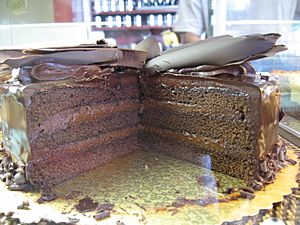
Chocolate is sold in chocolate bars, which come in dark chocolate, milk chocolate and white chocolate varieties. Some bars that are mostly chocolate have other ingredients blended into the chocolate, such as nuts, raisins or crisped rice. Chocolate is used as an ingredient in a huge variety of candy bars, which typically contain various confectionary ingredients (e.g., nougat, wafers, caramel, nuts, etc.) which are coated in chocolate. Chocolate is used as a flavouring product in many desserts, such as chocolate cakes, chocolate brownies, chocolate mousse and chocolate chip cookies. Numerous types of candy and snacks contain chocolate, either as a filling (e.g., M&M's) or as a coating (e.g., chocolate-coated raisins or chocolate-coated peanuts). Some beverages contain chocolate, such as chocolate milk, hot chocolate and chocolate milkshakes. Chocolate is a popular flavour of ice cream and pudding, and chocolate sauce is a commonly added as a topping on ice cream sundaes.
Popular culture
Religious and cultural links
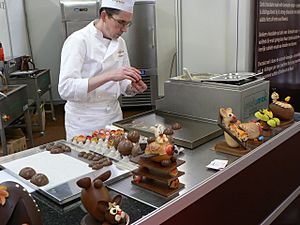
Chocolate is associated with festivals such as Easter, when moulded chocolate rabbits and eggs are traditionally given in Christian communities, and Hanukkah, when chocolate coins are given in Jewish communities. Chocolate hearts and chocolate in heart-shaped boxes are popular on Valentine's Day and are often presented along with flowers and a greeting card. Chocolate is an acceptable gift on other holidays and on occasions such as birthdays.
Many confectioners make holiday-specific chocolate candies. Chocolate Easter eggs or rabbits and Santa Claus figures are two examples. Such confections can be solid, hollow, or filled with sweets or fondant.
Images for kids
-
Paul Gavarni Woman Chocolate Vendor (1855–1857)
-
Chocolate soon became a fashionable drink of the European nobility after the discovery of the Americas. The morning chocolate by Pietro Longhi; Venice, 1775–1780
-
Silver chocolate pot with hinged finial to insert a moulinet or swizzle stick, London 1714–15 (Victoria and Albert Museum)
-
Dutch chemist Coenraad Johannes van Houten invented "Dutch cocoa" by treating cocoa mass with alkaline salts to reduce the natural bitterness without adding sugar or milk to get usable cocoa powder.
-
Fry's produced the first chocolate in solid state in 1847, which was then mass-produced as Fry's Chocolate Cream in 1866.
-
Maya glyph for cocoa
-
Toasted cocoa beans at a chocolate workshop at the La Chonita Hacienda in Tabasco.
-
"Dancing the cocoa", El Cidros, Trinidad, c. 1957
-
Fountain chocolate is made with high levels of cocoa butter, allowing it to flow gently over a chocolate fountain to serve as dessert fondue.
-
Packaged chocolate in the Ghirardelli Chocolate Company is stored in controlled conditions.
-
A gift box of chocolates, which is a common gift for Valentine's Day
See also
 In Spanish: Chocolate para niños
In Spanish: Chocolate para niños


